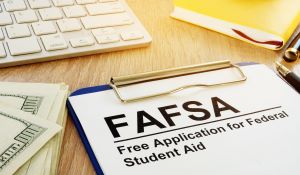The application window for federal student loans opens on October 1.
Mark this date on your calendar: October 1. That is the day when current and future traditional college students can start submitting the Free Application for Federal Student Aid (FAFSA) for the 2021-22 school year. For many students, the FAFSA is frequently the gateway to significant financial aid: federal and state student loans, grants, university scholarships, and work-study programs.1
FAFSAs should be sent in as soon as possible. The closer to “opening day” (October 1) you can do it, the better. Some states offer aid on a first-come, first-serve basis, and some universities set fall deadlines for financial aid requests.1,2
What do you need to complete the FAFSA form? First of all, the FSA I.D., which replaced the older PIN system some may recall. Your student needs one, and if your student is your dependent, you also need one. An FSA I.D. is a username-password combination that will let your student fill out the FAFSA form online (this can even be done with the myStudentAid mobile app on your smartphone). You can create your FSA I.D.s at pin.ed.gov. You can fill out the FAFSA form at the FAFSA website, fafsa.ed.gov, entering numeric codes for the colleges or universities your student is considering for the 2021-22 school year.3
Your student will need to enter a bunch of personal information, some of which will be yours if you have recently claimed them as a dependent. The basics? Birthdates, Social Security numbers, and even the student’s driver’s license number, if applicable.
Beyond the basics, financial information is needed, both from you and your student, including checking and savings accounts’ balances, investment account values, and business and rental property assets. Untaxed income (such as interest income and child support) must also be reported. In addition, you will need information from your 1040 income tax form for the 2019 tax year. Most of this tax information can be easily imported right into the FAFSA form, thanks to its Data Retrieval Tool, which connects directly with the Internal Revenue Service. Not everyone is able to use the DRT, though, and not all info carries over, so keep your 1040 forms from 2019 handy.3,4
Has your household income fallen since 2019? Then your student might qualify for more financial assistance than the FAFSA form calculates. A student can appeal an aid decision or ask for an adjustment to financial aid offered at any time, even during the midst of a quarter or semester.5 If you or your student need to pursue an adjustment, the first step will always be contacting the financial aid office of the school or institution in question.
You may have some leverage here. Enrollment is dropping at many universities, due to the pandemic, and the perception that pricier schools can’t currently offer a real college experience. Virtual classes might still be the norm in the Fall 2021 term. Attracting quality students is a top priority, and financial aid offices may be ready and willing to negotiate new aid packages well into the 2021-22 academic year.
Whenever a college considers awarding financial aid, it looks at the expected family contribution (EFC), which is calculated according to a formula set by law. The EFC is the amount of money the college believes you can pay toward your student’s education, and the EFC factors heavily into calculations of need-based aid (as opposed to merit-based aid, like scholarships).5
If your student receives more need-based aid, that may, in turn, reduce your EFC. Any revision of need-based aid can also potentially impact a student’s estimated cost of attendance (COA); sometimes, the COA rises with changes in financial aid. When the COA rises, or the EFC falls, a household may be eligible to apply for work-study programs and subsidized college loans.5
Creekmur Wealth Advisors may be reached at 866-358-4441 or Info@Creekmurwealth.com.
This material was prepared by MarketingPro, Inc., and does not necessarily represent the views of the presenting party, nor their affiliates. This information has been derived from sources believed to be accurate. Please note - investing involves risk, and past performance is no guarantee of future results. The publisher is not engaged in rendering legal, accounting or other professional services. If assistance is needed, the reader is advised to engage the services of a competent professional. This information should not be construed as investment, tax or legal advice and may not be relied on for the purpose of avoiding any Federal tax penalty. This is neither a solicitation nor recommendation to purchase or sell any investment or insurance product or service, and should not be relied upon as such. All indices are unmanaged and are not illustrative of any particular investment.
Citations.
1. University of Nevada, Las Vegas, August 13, 2020
2. StudentAid.gov, August 13, 2020
3. StudentAid.gov, August 13, 2020
4. University of New Mexico, August 13, 2020
5. Forbes, July 28, 2020



